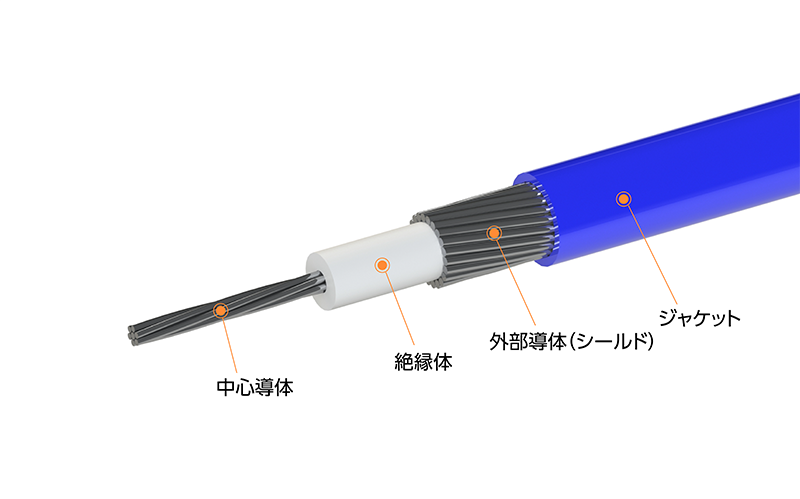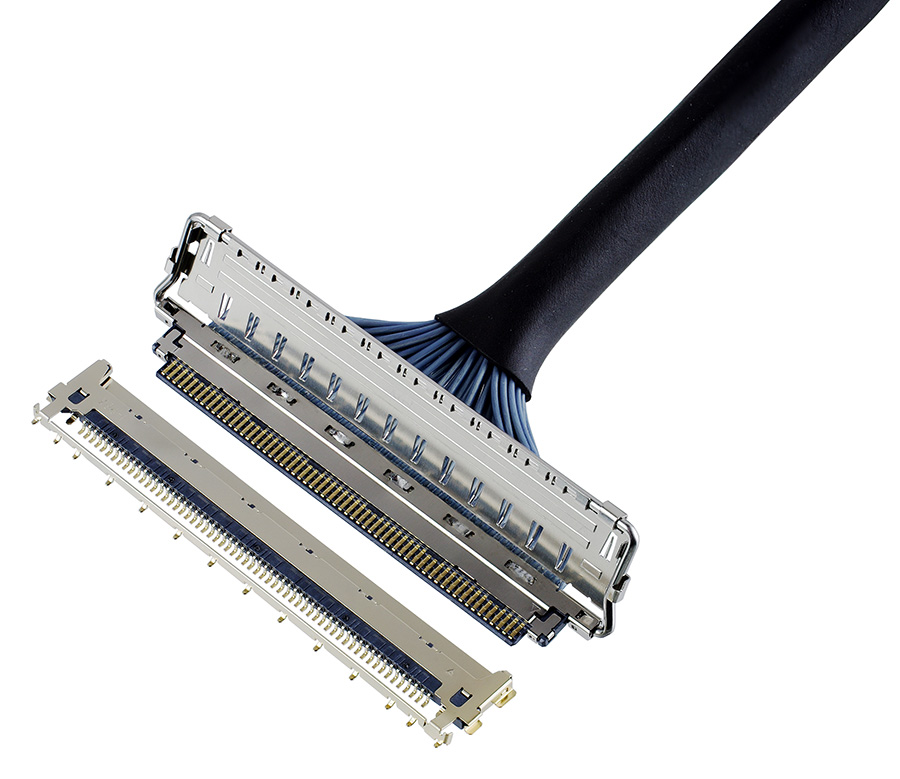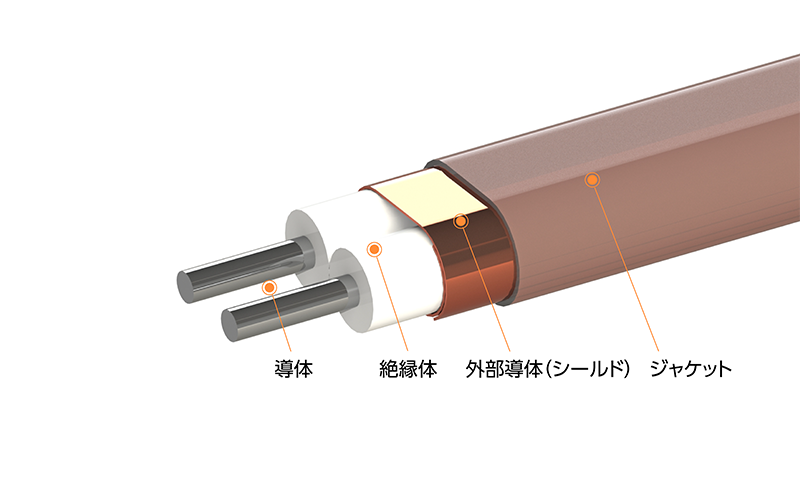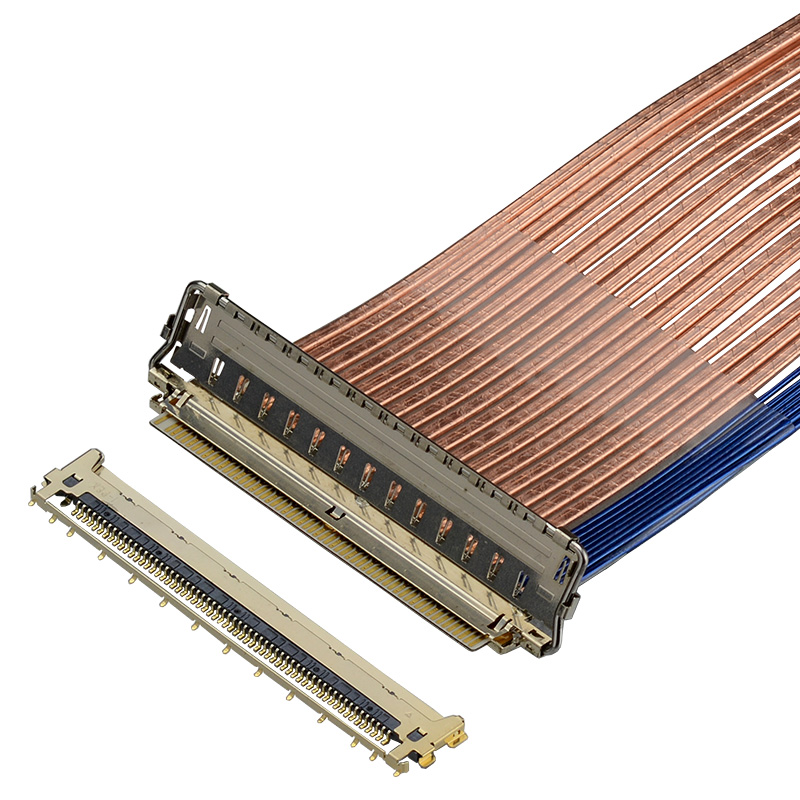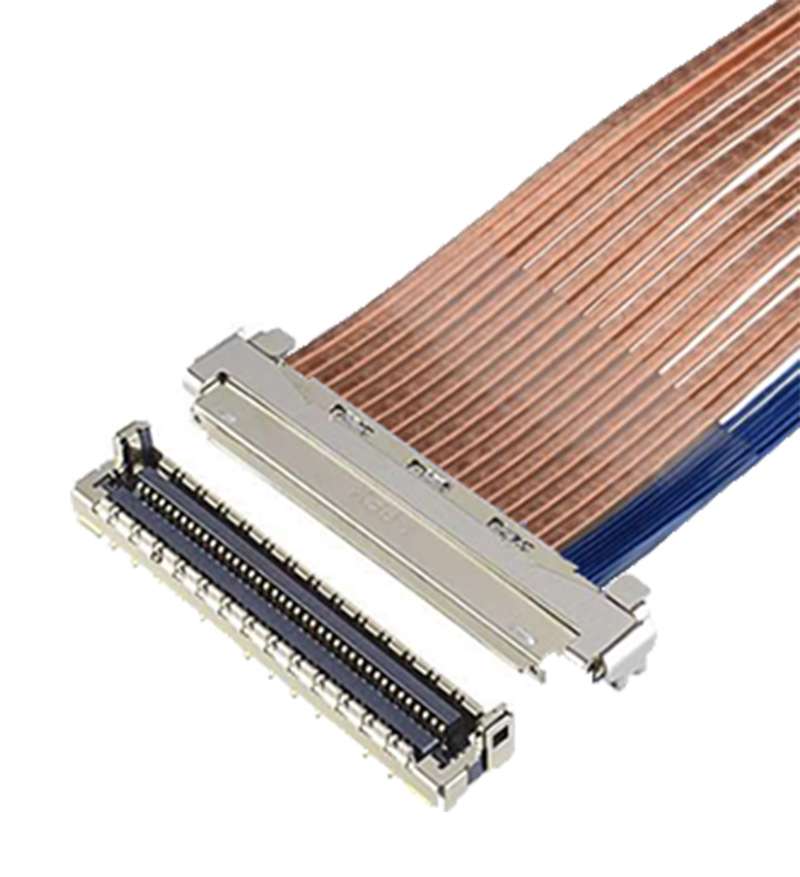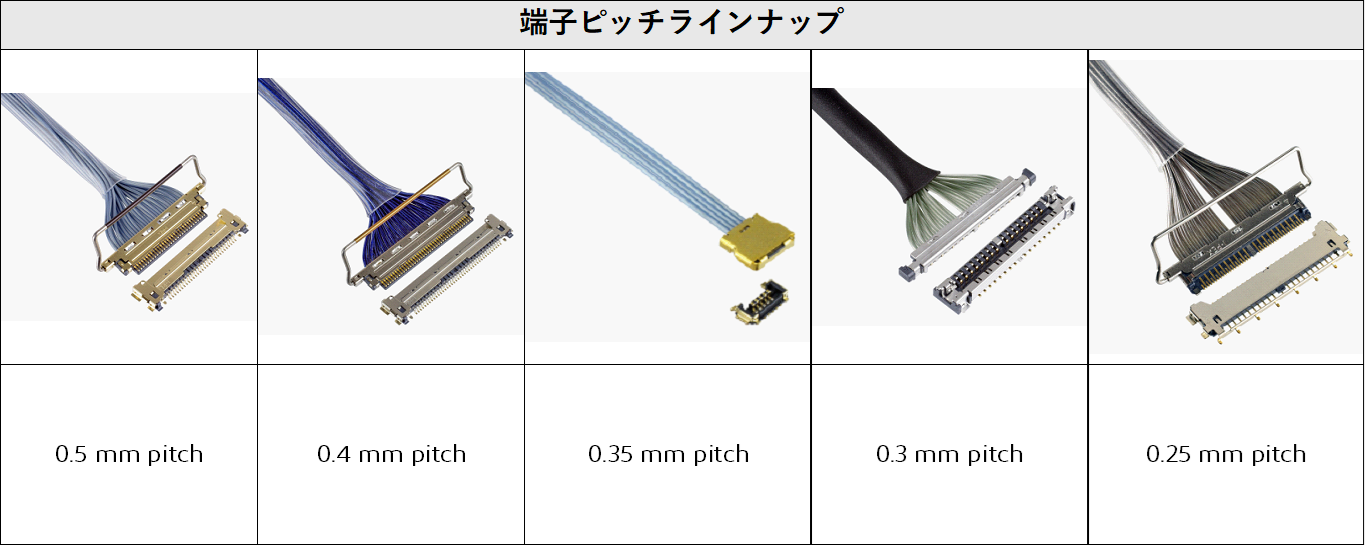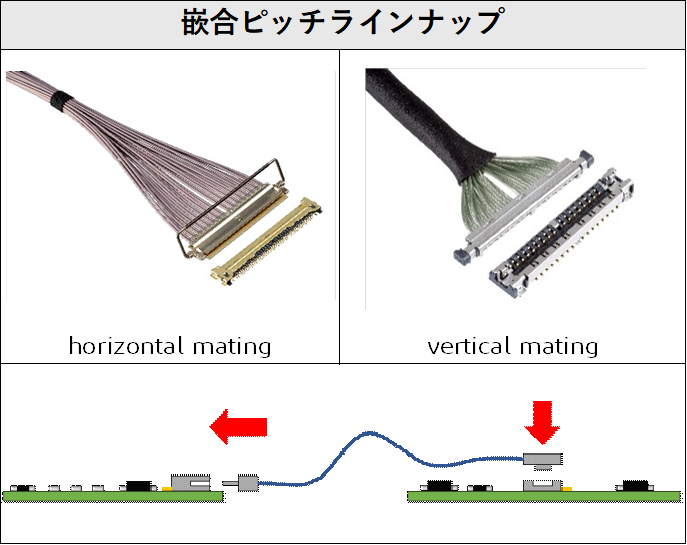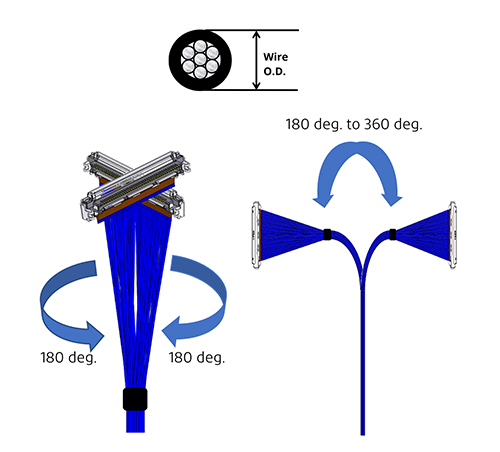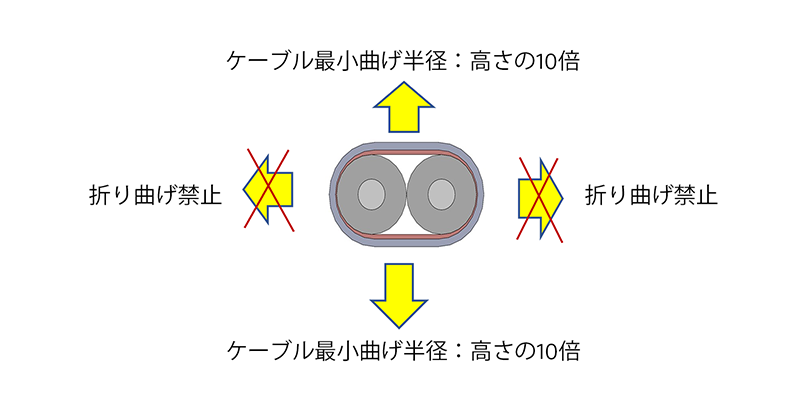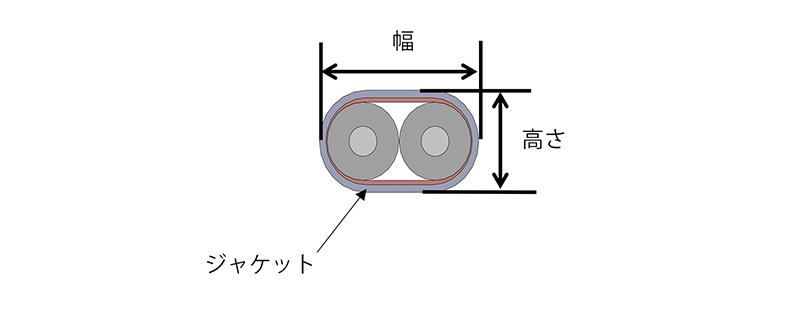細線同軸・Twinaxialコネクタ
I-PEXは細線同軸コネクタのパイオニアであり、1996年に世界で初めてCABLINE®細線同軸コネクタを量産しました。最適な細線同軸およびTwinaxialケーブルハーネスを選定する際には、最大動作周波数、利用可能な面積、EMI(電磁干渉)シールドの必要性、アウタージャケット/編組の種類などが重要な検討事項となります。
これらのハーネスにおける主な損失には、インサーションロス(挿入損失)、リターンロス(反射損失)、およびVSWR(電圧定在波比)があり、これらを最小限に抑えるためには、適切なサイズと長さのケーブルを選定し、コネクタプラグへの終端処理を正確に行う必要があります。
設計におけるケーブルの配線ルートに応じて、ハーネスの曲げ、屈曲、ねじれ特性を考慮することも重要です。また、信号のピン配置、レイアウト、基板トレースの配線が設計によって異なるため、これらのハーネスアッセンブリには異なるピンアウトが求められる場合があります。
現在の高速プロトコルの多く(USB4、Thunderbolt、PCIe Gen 6およびGen 7など)は、これらのコネクタおよびアッセンブリによってサポート可能です。
このページでは、ハーネス製造プロセスの概要も紹介しており、各工程の詳細が説明しています。
目次
- 1) 細線同軸ケーブルハーネス
- 2) Twinaxialケーブルハーネス
- 3) アプリケーションでの最大動作周波数
- 4) コネクタのための利用可能な面積
- 5) EMIシールドと電源信号
- 6) 損失の最小化
- 7) ハーネスの曲がりや柔軟性、ねじれなどの条件
- 8) ハーネスアッセンブリに必要なピン配列
- 9) ジャケットと結束のタイプ
- 10) 高速プロトコル
- 11) ハーネス加工の工程
1) 細線同軸ケーブルハーネス
高周波信号は一般的にアンテナ、高速基板トレース、PCB上のトランシーバーなど、通信源の近くからの電磁波の影響を受けやすくなっています。細線同軸ケーブルを使用することで、これらの高速信号はノイズから十分に保護され、データのシグナルインテグリティが保たれます。細線同軸ケーブルは、絶縁のための誘電体コアに囲まれた信号伝送用の中心導体を含みます。グランドリターン電流のために複数の撚り線を持つ外側の金属ジャケット、さらに絶縁用にジャケットがあります。I-PEXは高周波信号用のフルシールドコネクタと、高い接続信頼性を保持するメカニカルロック機能(オプション)とともに完全な細線同軸ケーブルハーネスソリューションを提供します。
2) Twinaxialケーブルハーネス
Twinaxialケーブルは、低電圧、低スキュー、厳密な位相整合信号を使用する高速デジタルデータ伝送に適しています。また、これらのケーブルは、PCBトレースよりも熱放散が少なく、信号損失が小さいため、基板上のデバイスの相互接続に使用することができます。Twinaxialケーブルには、通常差動信号に使用される2本の中心導体があります。2本の導体は分離され、ゴムやプラスチックのような絶縁体で囲まれています。細線同軸ケーブルのように、これらの導体の周囲には絶縁のための外層があります。また、グランドリターン電流用の金属製外部導体シールドとPVCタイプの外部ジャケットがあります。I-PEXは高速差動信号用のフルシールドコネクタと、高い接続信頼性を保持するメカニカルロック機能(オプション)とともに完全なTwinaxialケーブルハーネスソリューションを提供します。
3) アプリケーションでの最大動作周波数
最大動作周波数は、通信システムの高速インターフェースにおいて、どれだけの速度でどれだけの量のデータを伝送できるかを決定します。高速デジタル・データ伝送における相互接続媒体のインピーダンス不整合と高い挿入損失は、閉じた信号アイダイアグラムを引き起こし、受信側での高いビットエラー率とデータ損失につながります。このため、高速信号を忠実に伝送するためには、インピーダンスの整った高性能で低損失のケーブル相互接続を使用することが重要です。CABLINE®シリーズの製品は低損失で、最大周波数16 GHzまで動作し、PAM4信号を使用して最大64 Gbpsのデータレートをサポートします。CABLINE®シリーズでは、USB、eDP、Display Port、PCIeなどのプロトコルに対応しています。
4) コネクタのための利用可能な面積
インターフェースのチャンネル数、必要なピン数、各ピンの間隔、プラグとコネクタの許容嵌合幅、長さ、プロファイルの高さによって、使用すべき適切なコネクタのタイプが決まります。また、PCB上の最大利用可能面積とコネクタの位置により、リセプタクルとプラグのハーネスアセンブリの取り付け形状が決まります。I-PEXは、CABLINE®シリーズの高速コネクタで、水平と垂直の両方の実装構成、様々なサイズとピン数のコネクタを提供しています。
5) EMIシールドと電源信号
電源、低速制御、高速データ信号をすべて同じハーネスで伝送する必要がある場合があります。表面実装部品が近接していたり、システム内にノイズが存在するため、信号をEMIやクロストークから保護する必要があります。I-PEXはZenShield®と呼ばれる360度完全なEMIシールドソリューションをFPCケーブルと、CABLINE®シリーズ製品の細線同軸ケーブルとTwinaxialケーブルのプラグの双方に提供しており、信号コンタクトと嵌合コネクタのはんだ付け側の両方をEMIノイズからカバーしています。
ZenShield®は、CABLINE®-VS II、CABLINE®-VS IIF、CABLINE®-CA II、CABLINE®-CA II PLUS、CABLINE®-CA IIP PLUS、CABLINE®-CA IIF、CABLINE®-CX IIおよびCABLINE®-UMシリーズ製品に搭載されています。
6) 損失の最小化
挿入損失、リターンロス、VSWRは、高速Twinaxおよび細線同軸ケーブルアッセンブリの重要な性能指標です。高性能な細線同軸ケーブルは、高速アプリケーションにおいて優れたシグナルインテグリティと損失の低減をもたらします。I-PEXでは、自動化されたアッセンブリプロセスにより、一貫した高品質と低損失を保証する高性能CABLINE®細線同軸ケーブルとTwinaxialケーブルアセンブリ完成品を誇りをもって提供します。
7) ハーネスの曲がりや柔軟性、ねじれなどの条件
最小曲げ半径は、細線同軸ケーブルとTwinaxialケーブルの両方が、これらのケーブルが損傷を受けることなく、かつ高いシグナルインテグリティを維持したまま繰り返し曲げることができる強さを決定するパラメーターです。最小曲げ半径は通常、ミリメートル単位で測定されます。また、細線同軸ケーブルは、Y軸に沿ってケーブルの回転運動を許容するパラメータであるねじれについても指定されており、通常、度単位で測定されます。 細線同軸ケーブルに関しては、ケーブルの推奨最小曲げ半径は「ワイヤー外径の6倍」ですが、実際の仕様はお客様が選択した同軸ケーブルによって異なります。
Twinaxialケーブルの場合、ケーブルの構造上、以下のように高さ方向にのみ曲げや屈曲が制限されます。Twinaxialケーブルの最小曲げ半径は、ケーブルの高さの 10 倍と規定されています。Y 軸方向に曲げたりすることはできません。
8) ハーネスアッセンブリに必要なピン配列
信号のピンアウト、レイアウト、基板トレースの配線により、ハーネスアセンブリの各コネクタでピン配置が異なります。I-PEX高速ハーネスアッセンブリでは、配線や配置の柔軟性を考慮し、1-Nタイプのストレート・ピン配列と1-1タイプのミラー・ピン配列の2種類のピン配列を提供しています。
9) ジャケットと結束のタイプ
高速ケーブルハーネスには4種類のアウター、テープ、またはジャケットが用意されており、配線や配置の柔軟性を高める設計が可能です。 バンドル・テープは、ハーネスのケーブル・エリアの一部、大部分、またはすべてをカバーする複数のポイントでケーブルに巻き付けることができます。また、スペースに制約のあるシステム向けに、軽量で透明なアウタージャケットを使用し、高速放熱と均一な応力分布を必要とするフラットバンドルタイプのオプションもあります。
10) 高速プロトコル
USB 3、USB 4、Thunderbolt、Displayport、eDP、HDMI、MIPI、PCIe Gen 5およびGen 6は、PAM4信号タイプを使用した最大データレート64Gbps/Laneで一般的にサポートされているプロトコルの一部です。
I-PEXは、MIPI、PCIe、USBなどの特定の業界標準に適した利用可能なコネクタオプションを検索するツールを提供します。同時に、I-PEXの各高速コネクタがどの業界標準をサポートしているかを確認できます。
11) ハーネス加工の工程
プラグハーネス加工の主な工程:
- ケーブルサブアッセンブリを用意
- ケーブルサブアッセンブリをプラグハウジングアッセンブリ部品にセットし露出した導体をプラグ信号端子にはんだ付け
- ロックバーアッセンブリ(またはロックバー)をプラグハウジングアッセンブリ部品にセット
- プラグシェルを被せ必要個所をはんだ付けしするとプラグハーネスが完成

